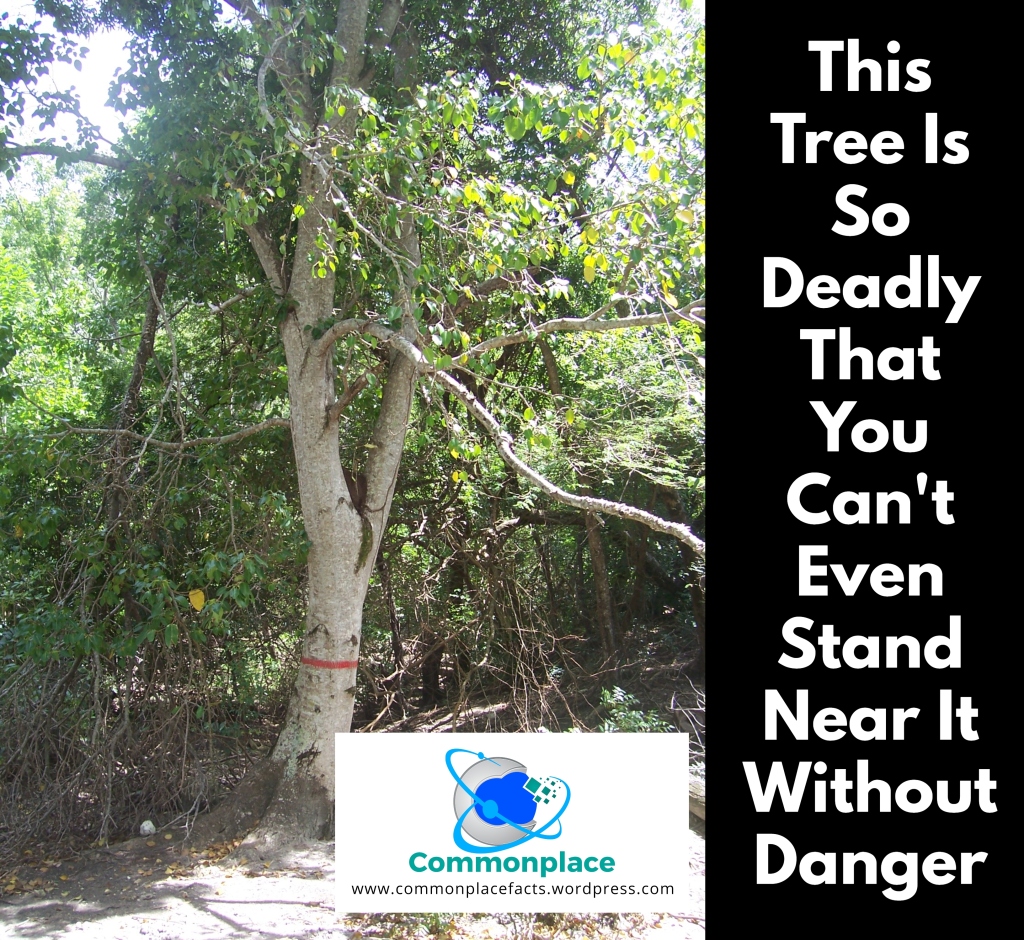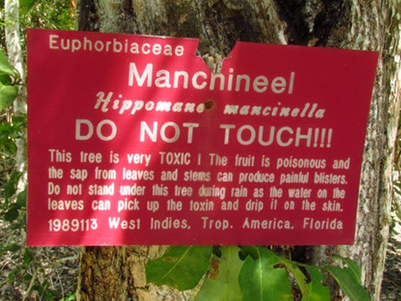Joyce Kilmer wrote, “I think that I shall never see a poem as lovely as a tree…” Kilmer intended to express the beauty and serenity embodied by trees. If Kilmer’s inspiration had come from the manchineel tree, however, the poem would have taken a decidedly darker turn.
The manchineel tree is something that would seem to have come from the realm of dark fantasy. Tales of a tree that can cause blindness, blisters, and death by simply being in its vicinity sound too incredible to be true. If such an abomination were to exist, it must have found its origin on a hostile alien world; the very bowels of hell; Valparaiso, Indiana; or some other nightmarish realm.
Native to the tropical regions from southern North America to northern South America, the manchineel (Hippomane mancinella) holds the Guinness record as the world’s most dangerous tree. Its Spanish name, Arbol de la Muerte, translates as “tree of death.” Literally everything about the tree is deadly.
At first glance, it appears to be some sort of apple tree. Trust us when we say that you don’t want to sample the fruit. The Spanish name for the fruit is “manzanilla de la muerte.” Appropriately named, this translates as “little apple of death.” A single bite from the small, green fruit will cause blistering in the mouth and esophagus, as well as triggering severe abdominal pain. Ingesting even a tiny amount of the fruit can be fatal.
You don’t have to eat from the tree for it to be dangerous. The milky-white sap from the trunk is so caustic that one drop can eat through the paint of an automobile. Any contact with human skin triggers blisters. If the sap lands in the eyes, it can result in blindness.
The tree “sweats” its acidic sap so even casual contact with the tree can be a horrifying experience. If it is raining and you seek shelter under its branches, you will realize that you don’t even have to make physical contact with the tree to regret being near it. Standing under the manchineel in the rain is enough to cause blistering if the skin is wetted by raindrops containing any sap.
This sap contains a host of nasty toxins. The most serious reactions stem from phorbol, an organic compound that belongs to the diterpene family of esters.
The manchineel will even seek revenge if it is attacked. Try to burn one of the trees, and it sends its toxic sap into the air, causing blindness if it reaches someone’s eyes and respiratory scarring if it is inhaled.
Most fruit trees depend on animals to help spread their seeds. When animals consume the fruit, the seeds get distributed through excrement. Other seeds find their way to new territory by being buried by hoarding critters. The manchineel scoffs at such things and does not care if its fruit is too toxic to be consumed or handled. It grows near the shore and drops its fruit in the water, relying on waves and currents to carry the seeds to fertile ground.
As deadly and ghastly as it is, the manchineel has a surprisingly festive relative. As a member of the large and diverse Euphorbia genus, it is a cousin to the Christmas poinsettia.
Authorities try to warn the unsuspecting public (animals have to figure it out the hard way) about the dangerous qualities of the manchineel. When identified, the trees are marked with a red cross, a ring of red paint, or labeled with explicit warning signs.
Surely, you must conclude, there is a concerted effort to eradicate this foliage of hell from the face of the earth. Alas, you would be mistaken. Manchineel trees are protected as an endangered species. They play an important role in windbreaking and erosion control on Central American beaches.
Ingenious Caribbean carpenters even figured out a way to use manchineel wood for furniture. After carefully cutting the wood, it is laid out in the sun to dry. Once completely dry, the sap is neutralized, making the wood safe to use.
There are no records available about how many carpenters lost their skin, eyes, lungs, and lives before this process was fully understood. We are also seeking information about anyone unfortunate enough to sit in a manchineel chair composed of wood that was not quite fully dried.
Discover more from Commonplace Fun Facts
Subscribe to get the latest posts to your email.
Categories: Accomplishments and Records, Death, Nature, Strange Deaths




Wow really amazing nature😍
LikeLiked by 2 people
This tree grows on the island of Chacachacare here in Trinidad, a lot of people don’t seem to know that its poisonous…
LikeLiked by 1 person
Wow. I would think this would be something everyone would be taught — probably in the same lesson as “don’t pet rattlesnakes.”
LikeLiked by 1 person
you bet!!! great blog, I like the info…
LikeLiked by 1 person